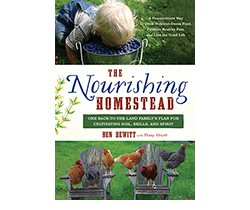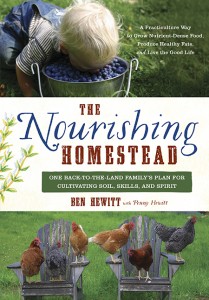
 copyright the Chronicle December 3, 2014
copyright the Chronicle December 3, 2014
The Nourishing Homestead: One Back-to-the-Land Family’s Plan for Cultivating Soil, Skills, and Spirit, by Ben Hewitt with Penny Hewitt. Published by Chelsea Green Publishing, White River Junction, 2015; Paperbound, 352 pages; $29.95.
Reviewed by Joseph Gresser
Some books need to be written again as each new generation comes of age. Walden, by Henry David Thoreau, may have set the template for one of these books, the exhortation to the reader to give up conventional expectations and live a radically simplified life.
Living the Good Life, by Helen and Scott Nearing, set forth a version of that message adapted for a very different world. To give them full credit, the Nearings lived according to their principles far longer than the year or two Mr. Thoreau spent in the woods.
Another, less famous, entry in this category is Will Cuppy’s How To Be A Hermit, detailing his eight years of escape from New York City. Mr. Cuppy, whose book has a more humorous slant than the other two, lived in a small shack on a Long Island beach.
A couple of weeks ago a package arrived at the Chronicle’s office containing an advance copy of another book in this sturdy chain, The Nourishing Homestead.
Its author Ben Hewitt presents the way of life he and his family have pursued over the past 15 years as a model of how to step away from a society that he sees as depriving the individual of fulfillment and, literally, of nourishment.
Instead of conforming themselves to the needs of the cash economy, Mr. Hewitt and Penny, his wife, bought a 40-acre homestead in Cabot. With some prior knowledge and a large amount of trial and error, the couple transformed it into something that resembles, in Mr. Hewitt’s telling, an Edenic home for the couple, their two sons, and the animals and plants with whom they share their lives.
That last phrase is more than a rhetorical touch. The Hewitts’ style of homesteading is based on the belief that the soil, the plants, the animals, and the people are totally interdependent.
Like Mr. Thoreau and the Nearings, the Hewitts are thrifty, avoiding debt and unnecessary expenditures. Mr. Hewitt’s advice to his contemporaries in this regard differs from his literary forebears. For instance, he suggests that it is possible to get along without buying the latest model iPhone, an earlier version will suffice.
Mr. Hewitt’s views on thrift are straightforward and practical. His family, aside from underwear and shoes, is clad in second-hand clothing.
The family’s ideas about diet are somewhat less conventional. Cholesterol, he says, is essential for healthy brain functioning, while whole grains contain phytic acid, which prevents the assimilation by the body of necessary nutrients.
I’ve lived long enough to see views on what fare is best for the human organism change so many times that I take any pronouncement on the subject with a grain of salt, or with a dose of mild skepticism if salt is prohibited.
The family’s mode of eating, though, is very much in keeping with its philosophy of life. As hay is converted to meat with the help of cows, pigs, and chickens, the most valuable commodity is fat, whether in the form of butter or lard, Mr. Hewitt writes.
To ensure a good return on the labor the whole family puts into their homestead, the Hewitts put a great amount of effort into tending their soil. This involves far more than spreading compost and manure.
In fact, Mr. Hewitt says that compost and manure from land lacking in the proper mineral balance, can actually weaken the soil.
His brief, but comprehensive, outline of how the family uses carefully calibrated applications of soil amendments to boost both yields and the quality of vegetables, hay, and other plants, is very much the heart of the book.
While I am not about to take on the responsibility of managing a diversified homestead like the Hewitts’, I am a fairly serious gardener. At the very least, the chapters on soil have provided me with food for thought.
Although Mr. Hewitt has strongly held beliefs, his prose style is clear and genial — never hectoring. What he and his family have done may be useful as a model for someone else, but it is offered only as an option.
That makes the book a useful guide for someone new to rural living who hopes to raise a substantial portion of his diet. On matters with which I have practical experience, I find Mr. Hewitt’s advice to be clear and accurate.
For urbanites, or those past the point where slaughtering and butchering one’s own hogs sounds like fun, it has much of the same charm as a sailor’s account of rounding Cape Horn on a three-masted schooner in a howling gale — it’s fascinating to see how it’s done, even if the temptation to ship out is weak to non-existent.
The Nourishing Homestead provides a helpful and inviting guide to navigating the complexities of the simple life.
contact Joseph Gresser at [email protected]
For more free articles from the Chronicle like this one, see our Reviews pages. For all the Chronicle’s stories, subscribe:
Print subscription
Annual online subscription
Short-term online subscription







